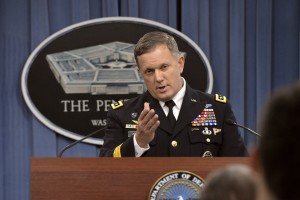Special to WorldTribune.com
WASHINGTON — The United States has defined its military mission in northern Iraq.
Officials said the U.S. air campaign against Islamic State of Iraq and the Levant was limited to protecting American troops in northern Iraq. They said the air campaign did not envision the destruction of ISIL’s presence in the autonomous region of Kurdistan.

“There are no plans to expand the current air campaign beyond the current self-defense activities,” Lt. Gen. William Mayville, director of operations at the Joint Chiefs of Staff, said.
In a briefing on Aug. 11, Mayville stressed that the daily air strikes by U.S. fighter-jets and unmanned aerial vehicles were meant to stop an ISIL assault on American troops in Kurdistan. About 200 Americans were staffing a joint operations center in the Kurdistan capital of Irbil, which also contains a U.S. consulate.
“We’re going to do what we need to do to protect our facilities, protect our embassy, to protect our American citizens, and to reduce this siege, as well as protect those aircraft that are providing support to Mount Sinjar,” Mayville said.
In all, the U.S. military maintains more than 1,000 personnel, including Marines and special operations troops, in Iraq. On Aug. 12, the Defense Department reported the deployment of an additional 130 advisers to Irbil, raising the U.S. military presence in Kurdistan to at least 300.
“The president has authorized me to go ahead and send about 130 new assessment team members up to northern Iraq in the Irbil area to take a closer look and give more in-depth assessment of where we can continue to help,” Defense Secretary Chuck Hagel said.
In August, the U.S. military conducted about 20 missions against ISIL in Kurdistan. Officials said the U.S. Air Force deployed the F-15E and F/A-18 fighter-jets as well as MQ-1 Predator UAVs around Irbil.
“These air strikes have helped check the advance of ISIL forces around Sinjar and in the area west of Irbil,” Mayville said.
Britain and the United States have also been dropping supplies around Mount Sinjar, where thousands of Yazidis sought to escape ISIL. The humanitarian mission as well as the air strikes have been supported by up to 50 intelligence, surveillance and reconnaissance flights per day. On Aug. 12, an Iraq Army Mi-17 helicopter on a humanitarian mission crashed near Mount Sinjar.
“U.S military forces continued to attack ISIL terrorists in Iraq today, successfully conducting an air strike on an ISIL mortar position north of Sinjar,” U.S. Central Command said on Aug. 12.
Officials said the U.S. air strikes were not expected to halt the ISIL campaign in northern Iraq. They said Washington and other NATO allies were arming the Kurds to protect Irbil.
“What I expect the ISIL to do is to look for other things to do, to pick up and move elsewhere,” Mayville said. “So, I in no way want to suggest that we have effectively contained or that we are somehow breaking the momentum of the threat posed by ISIL.”

You must be logged in to post a comment Login